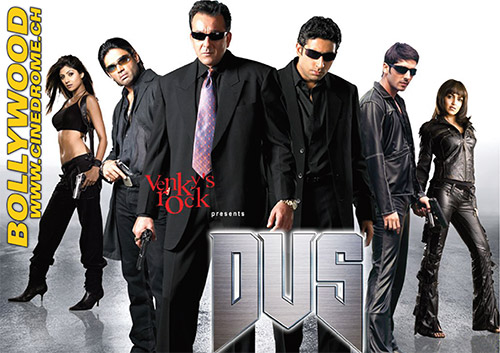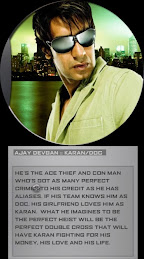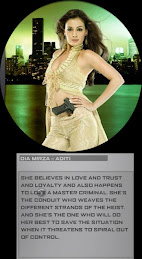Since the birth of the industry, Bollywood has come a long way from presenting us the dominant male and under-representing women in film. Bollywood today holds a position where this stereotype is being subverted and is increasing the significance of women in film. I will argue that the traditional patriarchy in Bollywood films is changing and that woman are becoming active and breaking the stereotype of the passive female. In spite of this, however, Bollywood heroines are now playing central roles yet they are being mis-represented, in effect becoming the subject of the “male gaze”. In film ‘Cash’ (2007) [1] women are portrayed as professional and independent beings, which are breaking the traditional passive female in Bollywood. The film portrays the significance of women and that they are not dominated by the typical male character.
Heroic roles have changed over the years since the mythological text ‘Mahabharata’. Indian mythology Mahabharata [2] was about kings, princes and gods and goddesses. In this sacred text, male protagonists were involved in wars, battles or in controlling the nation, while female characters were the goddesses and wives of soldiers, or entertainers for the rich. In fact, women were hardly seen on screen, female characters were not given any importance compared to men; the myths strongly focused on male characters due to religious idolatry. Although we saw the occasional vulnerable King lured by a queen, this showed woman as temptresses rather than as independent, resourceful beings. In the 1930s, heroes often played a gentle romantic role, sensitive to love and romance. In the 1940s, the anti-hero was introduced, for example ‘Awaara’ (1951)[3] in which Raj Kapoor turns away from crime and violence when he is redeemed by the women he loves. Later on, in the 1960s, heroes became more confident and stronger which had showed some greater sex appeal. In the 1970s, filmmakers gradually became more interested in action thrillers. In ‘Zanjeer’ (1973)[4], Amitabh Bachchan, plays the role of a cop who takes the law into his own hands to avenge the murder of his parents and other crimes. During the late 60s and 70s, male protagonists started to play more diverse roles. Male roles became authentic and gritty, moving on from texts such as Mahabharata, historicals about war, romances, social issues after partitioning of the country and corruption, and now to action, thrillers. Development of male roles made them active than ever before. Male roles had changed over time and male significance became stronger, reflected from “India’s growing confidence in its own destiny and influences creeping in from Western culture.” [5] The Indian film star Amitabh Bachchan stated “I believe leading men in Hindi cinema are modern manifestations of great heroes of Indian mythology. They are always invincible and they always win in the end” [6] Here Bachchan reinforces the idea of the man in film being more vital.
On the other hand, Heroines in the past have been playing romantic roles, to show beauty, elegance and charm, otherwise their roles have been scarce and at times barely shown on screen. Female roles were easy recognisable as heroine roles did not change over time, heroines were mostly shown sacrificing anything for their love or destiny, like in ‘Mother India’ (1957)[7]. They played a virtuous innocent roles but also wanting to show more sex appeal, heroines would be young, beautiful, shapely, have an expressive face and able to dance.[8] Typically within the narrative the heroine would be dependent on a patriarchal figure; this traditionally would be the father or the husband, this is shown in, ‘Shaan’ (1980)[9] where Sunil Dutt a brave police man, worked hard for his country and his wife Rakhee played as a loyal housewife, looking after their child. Another text that can be referred to the isolation of women would be ‘Khandaan’ (1965), this story is about a man Sunil Dutt who is the only breadwinner. Nautan a female character, which is house bounded, reinforcing the cliché of taking care of family, again showing females as housewives. We would stereotypically see them as housewives working in the kitchen or raising up the children whereas the man would be out to work making and bringing in money to the house. Idolisation of husband or father would be there for respect, this shows that Bollywood has always reflected from the Asian culture, because women always were expected to respect her Father and later her husband, she had to be prepared to transfer her allegiance to another male in her life. This meant that the daughter/wife was under the control of male character reinforcing the patriarchy in the Asian society and so film had adopted this value since the 1930s.
A great example of a historic film would be ‘Sholay’ (1975)[10], a retired police officer; Thakur Baldev Singh gets two convicts, Jaidev and Veeru, to imprison Gabbar Singh; a bandit chief who has been terrorizing the small village. Gabbar had massacred Thakur's entire family and even had his arms cut off. Unable to take revenge himself, Thakur recruits Veeru and Jaidev, who agree to capture Gabbar Singh and hand him over to Thakur. As the story goes along Veeru falls for a seductive local horse carriage driver Basanti; and Jai starts to have passionate feelings for Baldev Singh's widowed daughter-in-law, Radha. To make matters worse, Gabbar has sworn to kill both Jai and Veeru, and holds Basanti as a hostage, to lure them to her. This shows how the female is used as an object, which shows women have no significance, yet just using them as tokens. This film portrayed that there are so many different characteristics of man, and that the film includes two male protagonists showing the dominance of male characters, whereas we had only seen one female character which would be an driver of an horse carriage, this summed up that women did not have diverse roles, which shows that pre-1990 female roles compared to present time receive diverse roles which is getting them the importance and subverting the typical male dominance.
Contemporary Bollywood films are moving away from the traditional patriarchy and producing films which enlighten the fact that women in film are equally important as men. In ‘Cash’ female protagonists are all presented to be superior to men. The main female protagonist Shamita Shetty has a professional job, of high status compared to Ajay who is freelancer writer, Shamita is very confident and has an independent role where she is not in control of her Husband and is self-sufficient deciding everything on her own, without having to ask her husband. Another female character Esha Deol also has an independent role, who is single, a breadwinner and plays the game of cat and mouse chase, she is too fast and is an uncatchable driver. Dia Mirza another female character who also plays a role with her boyfriend (Sunil Shetty), she again is playing an independent role, where Sunil does not seem to have any control of her, yet she controls their relationship.
What follows is a close textual analysis of a scene in ‘Cash’[11]. In this clip we see Shamita Shetty in an establishing shot, abseiling, which connotes that she is brave, fit and active, whereas her husband Ajay Devgan is sleeping in the car. This shows a contrast between how active Shamita is compared to Ajay being lazy although fit and healthy; he plays more of a passive role. As Shamita is approaching her car after abseiling she is swaying her hips side-to-side which connotes that she is very arrogant, this creates a seductive feeling for the audience, especially the male audience, as her revealing costumes fulfils the male fantasy. As Laura Mulvey has suggested that women are only portrayed in the media as sex objects for the male gaze, this text is able to justify this, as the scantily clad character Shamita is being objectified through the male gaze. The dialogues which take place when she enters the car is ironic, when Ajay asks Shamita if they are going to have breakfast together or not, knowingly Shamita is going to work. She states that we would only have breakfast on one condition that is only if she drives, showing that she plays an active role. Here Shamita speaks boldly to her husband, whereas her husband speaking very gently, feeling intimidated by Shamita. After a small conversation we see Shamita driving the car home, while the husband is afraid and telling her to slow down, which shows that she is in control. This scene shows a complete role reversal of traditional gender roles, suggesting that Bollywood films have started to break the traditional patriarchy in film and the fact that character roles are being swapped, whereby women in film have become more significant than before.
Another close textual analysis of a scene from the film in which portrays how powerful the role of women has become, and that gender roles are being swapped. In this clip the two female protagonists are surrounded by group of furious women who are eager to beat up the two conning women. The two female protagonists fight against a group of women, where they perform a fighting sequence, where we see martial-art moves being used by the two female protagonists, which shows that women have learnt to defend themselves. This can also be referred to the modern Asian women in a contemporary society, who would keep herself safe by defending herself through self-defence. Although in Bollywood we would never have seen female protagonists fighting physically with other people, this shows how role-reversal is arising.
It is clear that the roles of female actresses in Bollywood have changed over time, especially in the 21st century where women are trying to raise their status in society as a whole. Bollywood has always been influenced by the west. As the media has become globalised, McLuhan’s theory on ‘The global village’ states that the media has become so diverse that everyone is connected through the media. Linking this to cinematic institutions such as Bollywood and Hollywood, they both are simultaneously connected in terms of Cinema, and so ideas are taken from one another of narratives and storylines. The film-makers of Cash surely would have seen the west portraying individualism in female characters such as Lara Croft in ‘Tomb Raider’ (2001)[12] and Uma Thurman in ‘Kill Bill’ (2003)[13]. ‘Cash’, revolutionized Bollywood in terms of character roles and female significance in movies by subverting the typical patriarchal ideology. This suggests that Bollywood is extremely inspired by Hollywood, and that now resourceful roles are given to women in Bollywood too, which is increasing the significance of the women. The common factor that revolves around the films are that they are all action, adventure, thriller genres and they are played by females, however they do create a sexual objectification yet increasingly we see great significance of women in Hollywood back in the 20th century, compared to Bollywood which started to increase its female significance in the 21st century.
According to today’s society, these representations of female protagonists in ‘Cash’ are fair, but these characters are to be seen scantily clad, which creates sexual references. The female actresses are seen as sex symbols, like in ‘Cash’ but play independent roles. The film’s denotative meaning would be that in this movie, the female protagonists are shown as independent role models in the contemporary Indian society, yet the film’s connotative meaning can be that they are shown as sex objects, who would be there for the 'male gaze' and that would fulfil the male fantasy. The female protagonists are to be seen as objects of the male gaze, due to their roles as well as their get ups which are their props. If we look at their clothing they seem to be scantily clad or be wearing tight clothes which pose the significant connotation of the protagonists. Referring back to ‘Sholay’, Basanti, the only female character shown on screen repeatedly driving a horse carriage around town, signifies the fact that she has no other role to play, but later on to fall in love with Veeru.
In Sholay the roles are strict with two active heroes and a passive heroine. One of the main differences are character roles- women in Cash have active roles, being strong, bold, outgoing, and social. On the other hand women in ‘Sholay’ are shown passive, being more feminine, fragile, naive, isolated in a small town; driving a horse carriage. The women in ‘Cash’ wear revealing costumes whereas in ‘Sholay’ women are fully covered, this shows that society was strict on exposure of the female body in the past, where they followed the norms and values of the Asian culture. The women in ‘Cash’ are shown working in professional field or having a significant job out in South Africa whereas in ‘Sholay’ female characters are just working in small towns of India, driving horse carriages. The ideologies which are highlighted in Sholay are patriarchy; where men are shown active by fighting and leading on the films narrative, whereas Basanti the carriage driver plays a seductive yet a rowdy female character who hardly appears on screen.
Identity change in Bollywood is occurring at the moment, we can say this because older films such as pre-1990 supported the subordinate passive roles along with the objectification of women for being sex symbols, such as in ‘Sholay’. On the other hand in contemporary films such as ‘Cash’ we have the portrayal of women being sex objects where there is more objectification through explicit songs and women being scantily clad but they play active roles which increases the significance of women in film.
The ‘New Man’[14] which was born in 1970s, where men’s thoughts and ideas changed, in simple terms the patriarchy was dying in society and men starting taking on female roles, men gave up their power over women. Linking this to my contextual study, men started to become equivalent to women which can be seen in ‘Cash’ where Ajay Devgan listens and obeys his wife’s instructions, therefore creating the meaning of ‘new man’ in contemporary Bollywood.
We would not have seen women being equivalent to men in the 20th century, because women were undermined and did not seem to have much importance or significance due to the patriarchy. They were just respected for merely the physical qualities they held. Although the female were known for ‘Expressive leaders’[15], where they kept all the family together, taking care of children, carrying out domestic duties, and being affectionate to everyone. Due to the same role being shown over and over again it created the cliché. However Cash shows that women are equally important as men in film, perhaps these changes are due to social issues which ‘Cash’ encountered, that the nation is progressing and is becoming contemporary and so will its film industry. Furthermore the ‘Brown Pound’ which is becoming successful in society allows film-makers to produce such films that portray a sensitive topic, highlighting the significance of women in film. Although it is ironic for this movie to show importance of women due to the historical films that had always supported the cliché, the ‘Cultivation theory’ is able to justify this as it is difficult to effect the audience with one individual text such as Cash, therefore film makers have made other similar contemporary films which would desensitise the audience to put the idea in effect that women are equally important as men in film.
However now some progress has been made and this can be seen from the film ‘Cash’. The film puts the Uses and Gratifications theory[16] in effect as the reasons of consuming the text is where Asian women would identify themselves to the female protagonists, for personal identity. Women in the Indian society might see these independent female protagonists in ‘Cash’ and take them as role models. Ultimately rejecting the typical male dominance and increasing the significance of the women. However where we see women as central, independent characters in Bollywood films, they are simultaneously objectified. Cinema critics state that ‘In the past, lead roles for women have always seemed scarce compared to males’[17] which enlighten us now women are now becoming the breadwinners. ‘Cash’ is a key text for Bollywood, because it emphasises the significance of women in film. Ultimately portraying that contemporary Bollywood is removing the traditional passive female and re-placing it with the active female.
Word Count: 2,728
[1] Directed by: Anubhav Sinha, 2007
[2] (Academic paper) James L. Fitzgerald, Department of Religious Studies, University of Tennessee, Knoxville 1999 http://web.utk.edu/~jftzgrld/MBh1Description.html
[3] Directed by Raj Kapoor, 1951
[4] Directed by Prakash Mehra, 1973
[5] Extract from ‘Bollywood and Beyond – The Hindi Film’. By Maureen O’ Brien, Page 13
[6] (Quoted in Kabir, 2001). ‘Bollywood and Beyond – The Hindi Film’. By Maureen O’ Brien, Page 13
[7] Directed by: Mehboob Khan, 1957
[8] Extract from ‘Bollywood and Beyond – The Hindi Film’. By Maureen O’ Brien, Page 15
[9] Directed by: Ramesh Sippy, released in 1980. http://www.imdb.com/title/tt0081491/
[10] Directed by Ramesh Sippy, 1975
[11] Clip between 2.15mins to 4.05mins. http://www.youtube.com/watch?v=iGCSm6zFNDE
[12] Directed by: Simon West, 2001
[13] Directed by: Quentin Tarantino, 2003
[14] The 'new man' - born in the 1970s. Reference to article- http://www.achillesheel.freeuk.com/article14_9.html
[15] (Academic Paper) Sociology AS by Stephan Moore, published in 2005, page 36
[16] Theory by Blulmer and Klatz, 1974
[17] (Academic Paper) www.brookdalecc.edu/fac/writing/jvarone/amsocmov/coleman














